Show your teeth! A very unique Gotha Go-242
About the Gotha Go-242
If there was a "workhorse" among the German cargo gliders, then the Go-242 deserves this title. Although the design of this glider broke new ground in many ways, the result was such a harmonious and successful construction that between the spring of 1941 and November 44, the remarkable number of 1481 models of the A, B and, to a lesser extent, C versions were built.
The attentive observer will notice two characteristic features at first glance: on the one hand, the double tail unit of the shoulder deck is supported by two fuselage outriggers; on the other hand, the wide-opening one-piece rear hatch and the wide cargo area that is so easily accessible are impressive. These two features were to prove to be innovations with a model effect; long after the Go-242, transport aircraft designs will continue to exploit the advantages of this design. The Fairchild C-119 or the Nord Noratlas are just two of many possible examples.
The history of the Go-242 began, as did many things in this field, with the surprising military successes that the comparatively small DFS 230 cargo glider achieved in commando operations at the beginning of the so-called Western campaign. In the enthusiasm of these victories, the RLM immediately requested the construction of a larger "wide-bodied glider" with a significantly higher payload in the spring of 1940. It did not take long: by June, prototypes from two different suppliers were already under construction at the Gotha wagon factory.
DFS, the "Deutsche Forschungsanstalt für Segelflug" (German Research Institute for Gliding), which had been responsible for the successful design DFS 230, had responded quickly and confidently to the invitation to tender with an advanced design: the new DFS 331 was conceived as a wide-bodied glider with a 23-metre wingspan, an aerodynamically favourable cockpit in the glazed nose and a double tail unit. Since DFS did not have the capacity to build the required three prototypes, the RLM transferred their construction to the Gothaer Waggonfabrik without further ado.
There, however, they had their own ambitious plans: at the same time as the DFS 331, the Go-242 had been designed there. With its fabric-covered tubular steel frame, the Go-242 had a rather conservative fuselage structure, but its great advantage was the excellent access to the cargo area close to the ground. Fast loading and unloading were key qualities in the military use of cargo gliders, as was the ability to carry bulky cargo- and in both respects the Go-242 was clearly superior.
Piquantly, both competing designs, DFS 331 and Go-2424, were to be built at the same time by the crew of the Gothaer Waggonfabrik. This ended in a predictable quarrel: the work on the three ordered prototypes of the DFS 331 progressed only slowly compared to the work on the first two Go-242s, which DFS claimed was a deliberate delay. On the other hand, the RLM's constant requests for changes to the overly advanced and complex DFS design further complicated the construction. The more robust Go-242, on the other hand, did not have these problems.
With the progress of the work and the subsequent flight testing of the two designs, the time finally arrived in autumn 1941. The Go-242 V1 took to the air for the first time on 11 November 41, three weeks before the first flight of the DFS 331 V1 had taken place.
At that time, however, it had already become clear that Gotha's own design would win the race. Innovative and yet uncomplicated in production and maintenance, the first twenty A-0 aircraft were ordered in November, while the former favourite DFS 331 was no longer of interest. From January 42, large-scale production of the Go-242 A-1 began, and a total of 1205 models of this version, by far the most important, were to be built over the next few years.
All common and thus available types could be used as towing aircraft; an advantage that contributed significantly to the widespread use of the Go-242 in almost all theatres of war. Towed from Ju-51, He-111, Ju-86 or even the He-111Z - here sometimes three loaded Go-242s at once - the cargo glider quickly proved its suitability. The wide cargo hold was ideal for supply flights, transport tasks, transporting the wounded or - increasingly needed in the second half of the war - evacuation flights.
The wingspan of the Go-242 was 24.5 metres, somewhat smaller than that of the competitor DFS 331, but its length of 15.8 metres could accommodate up to 23 fully equipped infantrymen or a corresponding load. Towing speed was around 240 km/h, the glide ratio was a moderate 15. The load capacity was calculated as follows: 3200 kg empty mass compared to 7100 kg maximum take-off weight.
The intensive use of the Go-242 was also reflected in the many equipment variants and modifications; in the course of its time in service, the cargo glider adopted all the improvements and aids that had been devised for cargo gliders. Neither the use of Walther take-off rockets nor the ability to perform extremely short approaches with a brake parachute released in the air remained alien to the Go-242. The B version, not shown here, could even tow another cargo glider behind it with a tow hitch mounted in the tail as standard. The Go-242 B mentioned here also had a full nose gear, while the A still took off with a jettisonable take-off trolley and landed on skids.
It underlines the importance of the type that a separate motorised variant was tested and put into service in small numbers. However, the aircraft, designated Go-244, proved to be clearly underpowered, as more powerful engines were not available, the usefulness of the cargo gliders had already been proven and, moreover, they were urgently needed, the few models were soon converted back to the glider configuration.
My model shows a Go-242 A-1 with a particularly attractive and unique colour scheme. The special thing about this example is that although it is well documented in photos, it cannot be clearly identified. Even the colour of the tail band is left open by the sources: yellow would point to a place of operation in the East, white to the theatre of war in Africa/Mediterranean. In the literature, the analysis of the equipment depicted and the environment visible in the pictures makes one quite confident that the aircraft was actually deployed in the Mediterranean; the colour of the tail band on the model was consequently white.
About the kit
Italeri has the honour of being the only manufacturer to have brought virtually all the major World War II cargo sailers into the range. The kit forms are all from the 60s and 70s of the last century. However, this is only noticeable in the period-specific approach to detail and the degree of toy-like quality of the models and is not, I may commend, at the expense of accuracy of fit or the quality of the injection moulding.
Accordingly, the Go-242 proved to be a fairly trouble-free and comfortable model to build from start to finish. Energies, which thus pleasantly remain free, are good to use for research, a shaken degree of post-detailing and for the partial re-engraving of the raised structures throughout.
The cockpit had to be rebuilt a little closer to the original; for example, the co-pilot's seat has its own set of rudder pedals, but instead of a fully formed control horn it only has a kind of "telescopic emergency stick". Various details in the cockpit were created with copper wire and etched parts from the scrap box.
A lot of extra work was also put into the design of the cargo hold, which is easily visible in parts. Here the strutting could be reproduced quite well with brass wire of different diameters.
However, the greatest adventure of this project turned out to be the wonderful "shark's mouth" on the bow. The decals were all useless anyway, which, among other things, consoled the fact that the enclosed decal for the "mouth" would have been fundamentally wrongly designed. To keep a longer story short: the friendly smile of the Go-242 was completely designed by masking and spraying. First, the colour of the teeth was applied to the nose in white, which was then masked off with cut-to-size masks - the part where one should breathe consciously every now and then before holding one's breath in concentration. This was followed by a final coat of red paint, which completed the painting job. After the dentures had been contoured with a black line on the original, they had to be reproduced with black decal strips and a little dry brush work in the round zones.
Finally, the two pairs of eyes, which are so characteristic for this model, were carefully applied to the respective surfaces with a dry brush.
The last pictures of this article with the assembled gliders indicate: with this Go-242 my personal "yearly theme of cargo gliders" in 1/72nd scale is once completed. I am happy about this small collection as well as about the many new insights I was able to gather in dealing with this exciting topic. For me, the Go-242 represents a true highlight in terms of type history and a worthy conclusion to this 72 series!
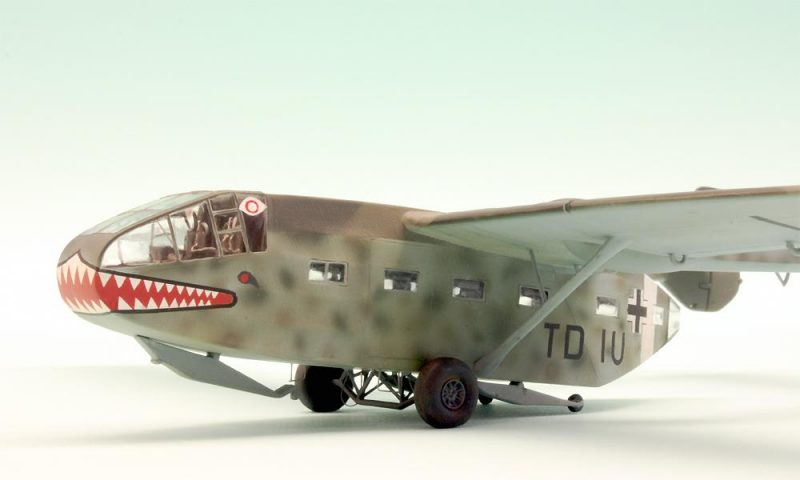
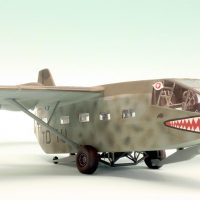
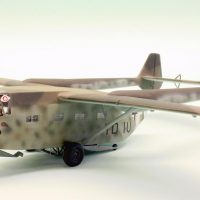
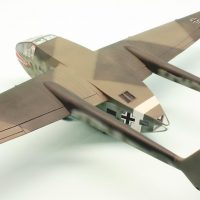
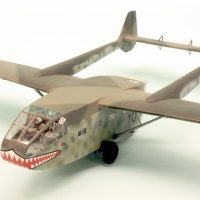
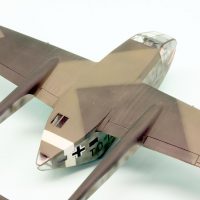
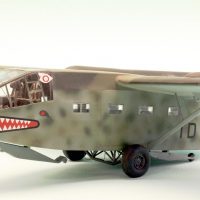
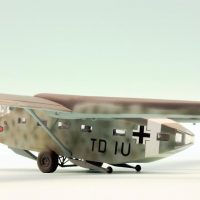
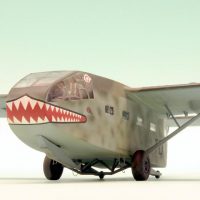
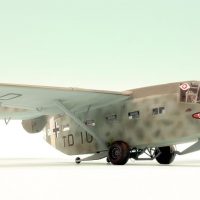
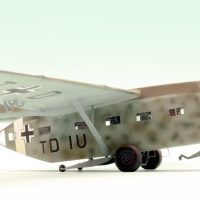
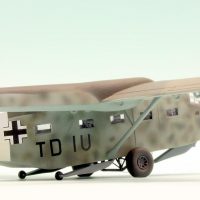

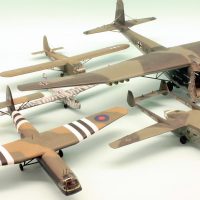
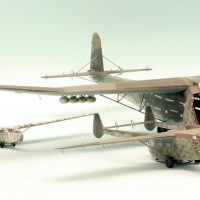
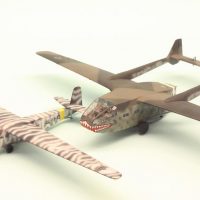
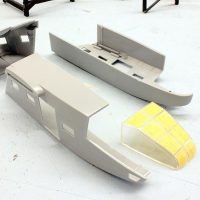
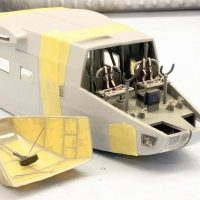
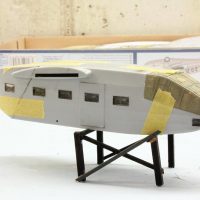
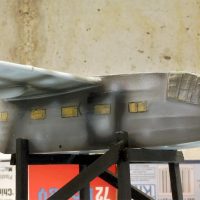
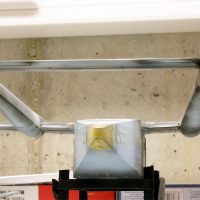
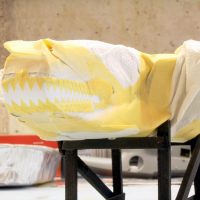
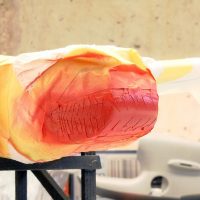

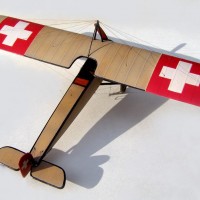

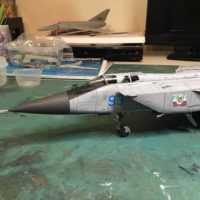
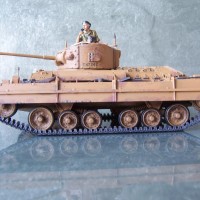
Very interesting and nice job, Roland. Love the group pic.
Thank you for your words, Gary!
Great build, Roland @rosachsenhofer
Sprayed teeth look so much better than decal ones.
That group pictures clearly shows the huge difference in dimensions amongst various gliders, thanks for showing us.
I am very pleased that you like it!
A very worthy addition to your glider collection, @rosachsenhofer.
Thank you Tom!
Excellent work and a great looking glider collection!
Nice job, Roland. I always wanted that one when I was a kid but never got it.
Good work, Roland... I like the teeth and the work you put into reproducing them in this scale. Your overall finish is very good as well.
This was one of the first 'new generation' of kits that started to appear in the mid-seventies, I think... I was certainly a mid-teenager at the time.
Italeri and the breakaway company, Supermodel, did some wonderful kits then - this Gotha, the Caproni 311/314, Ju86, and Supermodel's Bv138, and Cant Z1007, single and twin tail versions. Nowadays, they may be a little dated looking, but given patience, they still come up good.
I think a lot of their attraction was the complete and utter divergance from both the production standards and the run-of-the-mill subject matter of the day.
Your model brings back many enjoyable memories of those days; I like the other gliders in your collection, all of them very fine models. ICM are intending to bring out a 1/48 scale Go242 glider as well. Nice to see interesting subjects getting more attention these days.
Regards,
Paul
Superb Gotha, Roland. The mottle camo and teeth are excellent. The cockpit is very convincing at this scale - really important with so much glass to reveal it.
This is seriously cool. Great job, Roland!
Very nice. It’s one of the first kits I built since The end of my great « absence » from modeling during my lIfe.
I have one more in my stash !
Thank you for the historical. Amazing what Gotha did from starting out on building train cars ! One can see the expertise in this glider. Amazing realisation.
Thanks for showing.
Quality build Roland. I don't think I have ever seen a glider with teeth before.
Really nice work, Roland (@rosachsenhofer). Your airbrush work is terrific.
Beautiful work on your build, plus great glider collection.
An excellent model in every respect, Roland!
Amazing historical section, too!
Thank you all for your interest, encouragement and motivation! I am very happy about all your comments!
That's a great build! And great job getting that mouth and eyes on there so well. Really worth the extra effort.
Nice gaggle of gliders Roland, well done.
A great addition to your glider collection, Roland, I really enjoyed this post as well, definitely liked.
Thank you Greg, Allen and George for your interest and your motivating words!